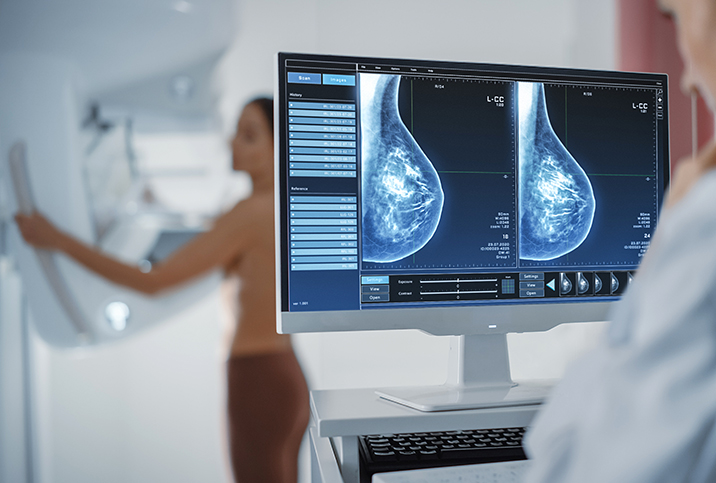What You Should Know About Lobular Breast Cancer

Invasive lobular carcinoma (ILC) is a type of breast cancer that starts in the lobules—the milk-producing glands—of the breasts. When the cancer cells spread past the confines of the lobules, it's considered invasive as it now has the potential to spread to the lymph nodes or other parts of the body.
The most common type of breast cancer is invasive ductal carcinoma, which starts in the lining of a milk duct within the breast and makes up 70 percent to 80 percent of all breast cancer cases.
"Lobular carcinoma is the second-most common type of breast cancer, accounting for approximately 10 to 15 percent of all breast cancers diagnosed," said Jennifer Hartman, a nurse practitioner who specializes in surgical breast oncology in Carmel, Indiana.
"Although it can happen at any age, ILC is most commonly diagnosed in women over the age of 55," added Danae Maragouthakis, M.P.H., M.B.B.S., co-founder and medical director at Yoxly, a sexual health resource based in London.
Lobular breast cancer symptoms and diagnosis
Breast cancer doesn't always show symptoms, which is why it's so important to have regular breast exams as advised by your doctor. If you have a family history of breast cancer, your doctor may recommend additional screenings.
"There is no major difference between lobular breast cancer in comparison with ductal breast cancer," said Jane Mendez, M.D., chief of breast surgery at Baptist Health Miami Cancer Institute. "Usually, breast cancer is asymptomatic but may present with a palpable breast mass, changes in the nipple, nipple discharge, skin induration, skin changes, an axillary mass, and a new breast asymmetry."
What's challenging about ILC in particular is that it can be especially difficult to diagnose because it doesn't always present as a breast mass.
"Lobular carcinoma also grows a different pattern from other breast cancers, making it less likely to feel like a lump and more likely to feel like a vague thickness or ridge," Hartman explained.
Lobular breast cancer can be diagnosed by:
- Magnetic resonance imaging (MRI)
- Mammogram
- Ultrasound
- Biopsy
Advanced technology, such as 3D mammography, can be especially helpful when diagnosing
ILC that does not appear as a breast mass.
Lobular breast cancer has a higher likelihood—compared to ductal breast cancer—of being diagnosed with contralateral breast cancer at the same time, Mendez said. Contralateral breast cancer refers to cancer spread between both breasts, as opposed to just one.
Risk factors for lobular breast cancer
The main risk factors for breast cancer in general are being a woman and growing older. However, there are modifiable and nonmodifiable risk factors, according to Mendez.
"In the nonmodifiable breast cancers, we include age and gender, certain high-risk pathology conditions, genetic mutations, family history of breast cancer, exposure to radiation, early menarche/late menopause, nulliparity [not having children], and delaying first childbirth," she explained.
The modifiable breast cancer factors, according to Mendez, include:
- Obesity
- A sedentary lifestyle
- Alcohol consumption
- Cigarette smoking
- Environmental exposures
- Hormonal replacement therapy (HRT)
Healthy lifestyle choices can make a difference in breast cancer risk, but nonmodifiable factors make eliminating all risks impossible.
Treatment
The good news is that ILC tends to grow more slowly than other types of breast cancer, Maragouthakis said.
"However, it is always important to seek prompt treatment, as ILC can spread and cause metastases," she said.
The treatment is similar to that of other forms of breast cancer, Hartman explained. Treatment usually includes surgery with some combination of hormone therapy, radiation therapy and chemotherapy.
Surgery
Surgery can include lumpectomy, where the surgeon removes cancer and a small portion of healthy tissue, or mastectomy, which is the removal of all the breast tissue.
"The surgical management will depend on the size and location of the cancer," Maragouthakis explained.
Hormone therapy
Hormone therapy can be used to control the growth of cancer. These medications may be used before or after surgery.
"Approximately 70 percent of all breast cancers, and approximately 90 percent of ILCs, have estrogen receptors," Maragouthakis said. "For those that do, hormonal therapies help to slow or stop cancer growth by lowering the body's estrogen levels, or by blocking the action of estrogen on breast cancer cells."
Radiation therapy
Radiation therapy uses X-rays to eliminate cancer cells. This treatment may be recommended after surgery to ensure the cancer was completely eliminated.
Chemotherapy
Chemotherapy can be administered in pill form or intravenously, and it is sometimes recommended before surgery to shrink a tumor or after surgery to kill any remaining cancer cells. It reduces the risk of cancer recurrence.
Coping with cancer
With technological advancements and modern medicine, breast cancer is treatable. And ILC is slow growing, so there is time. The five-year survival rate for invasive lobular cancer is high, at almost 100 percent when detected and treated early, according to Cleveland Clinic. Even when it spreads to nearby tissue, the survival rate is around 93 percent.
While the high survival rate is definitely something to cheer about, it doesn't take away the emotional distress of a cancer diagnosis. Being diagnosed with cancer, managing the symptoms and going through invasive treatments can all be seriously overwhelming—physically and emotionally.
It's so important at this time to take care of yourself. Your body is going through a lot. Rest, try to get quality sleep when you can and eat in a way that makes you feel good.
Seek support from family and friends. Grow a system of individuals that you can lean on when you need help. If you don't have people nearby, look into joining a cancer support group. Your doctor can likely advise you on where to look for groups.


















